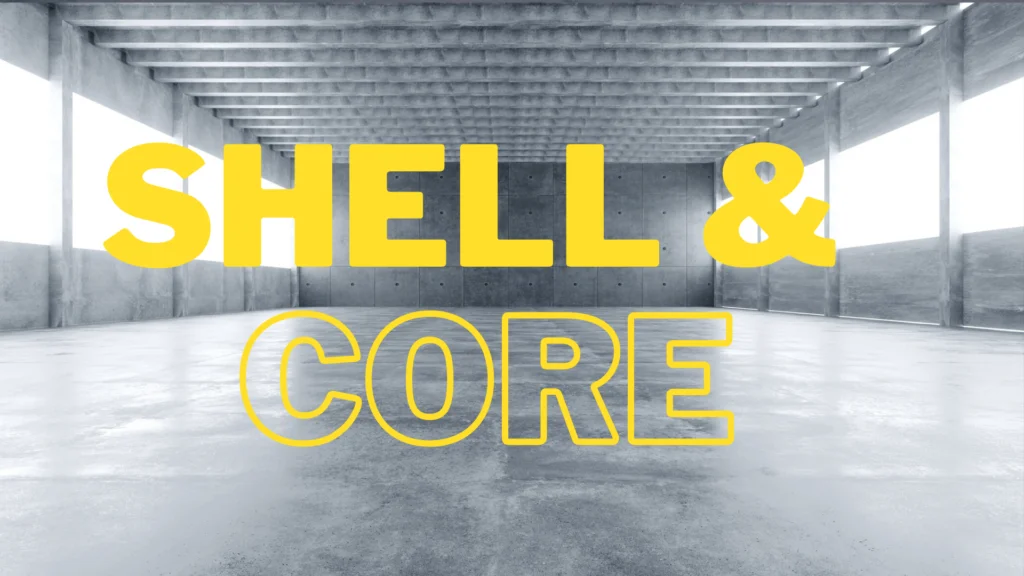You have to be the change to bring the change.

Meaning of the Phrase “Shell and Core”
Our content is reader-supported. We may earn a commission if you make a purchase through one of our links.
Ever heard a contractor referring to the phrase “shell and core” while describing his work? Well, you are not wrong if you stand unaware of this terminology, because it is specifically used by contractors and is an important part of construction language.
Every industry has phrases and terms which might seem unknown to people not belonging to the industry. Similarly, The phrase ‘shell and core’ may seem unknown to people who have little or absolutely no knowledge about construction and the language used in the business. Want to know more about this interesting-sounding phrase? Let’s dive into the complete information regarding “shell and core”.
What does “Shell and Core” Mean?
Shell and Core refers to the exterior of the building, including fireproofing, insulation, support panels, and studs, sealants, weatherproofing assemblies and materials, as well as the roof and roof membrane, all elevator shafts and stairways, and all structural elements of the building, such as the foundations, bearing walls, shear walls, pillars, beams, braces, and ceiling and floor slabs.
The phrase “shell and core” refers to a construction method in which the building owner designs and builds the foundation. Although the core and external elements (shell), as well as other construction operations, are included, tenant fit-out is left to the tenants before the building is occupied. This method creates a blank canvas for a tenant to design a suitable working environment that meets their specific needs. Shell and core construction is also known as “core and shell” or “base build.”
Origin of the Phrase
The concept of shell and core was first introduced in the United States. Prior to the invention of this method, building owners sold ready-to-use office space. An inefficient fit-out necessitated costly alterations, which was a waste of time and money.
Offices are typically found in shell and core structures occupied by a variety of tenants. It’s a win-win situation for landlords and tenants alike:
When it comes to renting out their properties, owners may offer tenants a variety of options.
If a tenant wants a one-of-a-kind room, they don’t have to build an entire structure.
The concept of a shell and core was first introduced in the United States. Before the invention of this method, building owners sold ready-to-use office space. An inefficient fit-out necessitated costly alterations, which was a waste of time and money.
Offices are typically found in shell and core structures occupied by a variety of tenants. It’s a win-win situation for landlords and tenants alike:
- When it comes to renting out their properties, owners may offer tenants a variety of options.
- If a tenant wants a one-of-a-kind room, they don’t have to build an entire structure.
What’s Included in a Shell and Core Building?
The shell and core approach, as previously established, is used to construct a building’s primary structural parts, such as its walls and windows. Interior features such as flooring and furnishings are not included in this strategy. Developers construct the basic framework, while renters personalize the inside to suit their tastes and requirements. Shell and core provisions include the following:
- The foundation and skeleton of a building
- Completed common areas, such as lobbies, reception, stairwells, restrooms, elevators, cellars, parking lots, and loading bays.
- This includes everything from insulation to exterior walls to windows to the roof.
Core and shell projects often have the following additional features:
- Paving, fences, and boundary walls are just a few of the elements that make up a landscape
- A wide range of systems include mechanical and electrical as well as plumbing, fire detection, and security
- Standards for signage as well as a statutory mandate
- Barriers to fire
When it comes to a core and shell project, there is no set of rules that dictate what must be included. As a result, renters should read the lease agreement thoroughly and meet with the landlord to clear up any questions they may have before signing.
Fit-Out Construction
Fit-out is the process of making an interior space fit for human habitation. Interior walls, flooring, mechanical systems, lighting, and electrical fixtures are all included in this category of furnishings and décor When a building’s fit-out is complete, it can be put to use. Fit-outs can be divided into two categories, depending on the building’s completion and the demands of the tenants.
Type A Fit-Out
Fit-out items that are done by the landlord or developer are included in this category. There is no agreed-upon definition, however, it might comprise the following elements:
- As a result, the floors and ceilings have been raised
- Mechanic and electrical work
- Finishes used to the inside of a building
- Blinds
For complicated fit-out requirements, tenants might participate in the core and shell projects to guarantee that their demands are addressed. Rather than having to alter an existing type, this will save both time and money. Fitting out
Type B Fit-Out
The tenant has complete control over the design of this sort of fit-out. It’s like a blank slate that may be filled in by the user. A type B fit-out consists of the following components:
- Offices and departments of customer service
- Meeting and conference rooms, as well as other amenities, are available.
- Kitchens
- Finishes and logos
- multi-media devices and systems
- Furniture
Aims and Objectives
There must be a clear definition of each of these characteristics in the lease agreement between the landlord and the tenant
The scope of the developer’s shell and core. Tenant appliances, like generators and chillers, can be installed in common areas.
All of the building rules’ criteria for occupancy other than those that will be accomplished by the tenants should be established by the landlord’s contract for the shell and core works.
Fitting-Out Costs
All of a property’s structural and exterior components are owned by the landlord, but he or she is not obligated to pay for the inside features such as carpeting and furnishings. All fees and charges will be laid out in the rental agreement.
The fit-out can be done in two ways. In the first scenario, the landlord purchases supplies and then leaves them stacked in the tenant areas for the tenants to utilize at their discretion. Some landlords, on the other hand, don’t supply the supplies but give free rent throughout the fit-out.
Conclusion
Predicting the demands of their tenants since each renter has a unique working area arrangement is a hard row to hoe for landlords. As a result, landlords might end up wasting a lot of money on tenant areas that have to be demolished and rebuilt all too frequently. Waiting for a new renter is more cost-effective than moving in immediately. The shell and core technique has the following advantages:
- Reduced costs and waste are achieved through a more efficient design-and-build process.
- Tenants have the option of completing their inside areas to their satisfaction.
- It is possible to include energy-saving features into a project that will benefit all of its residents.




We always had difficulty trying to explain what shell and core is to our clients. Thank you for this amazing explanation!!!!